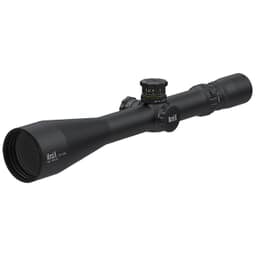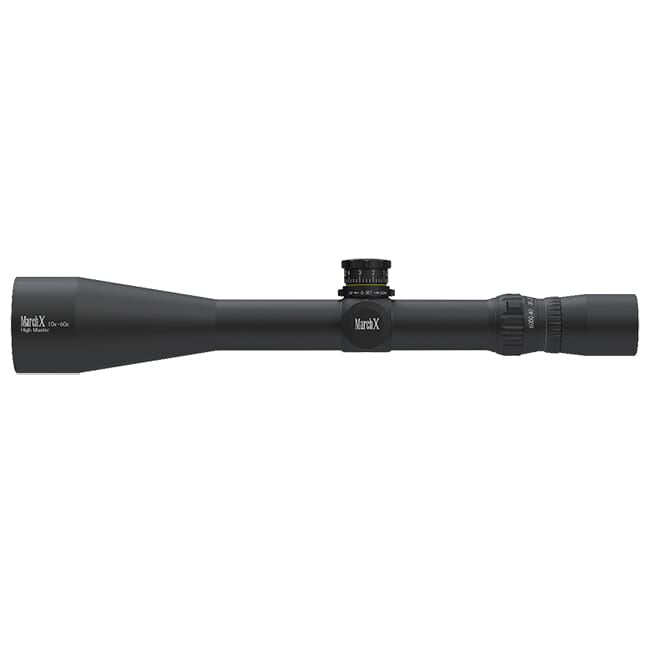Description
The March-X "High Master" 10-60x56 Riflescope offers competitive shooters a powerful tool for precision shooting. With a magnification range from 10x to 60x, this riflescope excels in various shooting scenarios, from benchrest competitions to varmint hunting. The scope features high-refractive ED lenses that ensure edge-to-edge clarity and natural color reproduction, enhancing your target visibility. The traditional crosshair dot reticle in the second focal plane provides a reliable aiming point while minimizing parallax error.
Exposed turrets with Zero-Set functionality allow for quick and accurate adjustments, ensuring you can dial in your shots with confidence. The side focus parallax adjustment accommodates distances from 10 yards to infinity, making it versatile for both short and long-range engagements. Constructed from aircraft-grade aluminum, the scope is built to withstand harsh conditions, ensuring durability and reliability during your shooting sessions.
Features – Key Benefits Bullets
- HIGH MAGNIFICATION RANGE for detailed targeting in various shooting conditions.
- EDGE-TO-EDGE CLARITY to enhance visibility and target acquisition.
- ZERO-SET FUNCTIONALITY for quick and easy turret adjustments.
- SECOND FOCAL PLANE RETICLE reduces parallax errors for precise aiming.
- PARALLAX ADJUSTMENT for distances from 10 yards to infinity for versatile applications.
- HIGH-REFRACTIVE ED LENSES ensure vibrant color reproduction and sharp images.
- ROBUST CONSTRUCTION from aircraft-grade aluminum for long-lasting durability.
- LIGHTWEIGHT DESIGN for easy handling and transport during competitive events.
Technical Specifications
| Specification | Details |
|---|---|
| Magnification | 10-60x |
| Objective Diameter | 56mm |
| Tube Diameter | 34mm |
| Length | 16.18 inches |
| Weight | 32.63 oz |
| Field of View | 10.2 - 1.7 ft at 100 yds |
| Eye Relief | Low: 3.15-4.21 in; High: 3.62-4.02 in |
| Reticle Position | Second Focal Plane |
What's in the Box?
- Riflescope
- Lens covers
- Padded case
- User manual
Customer Reviews
“The clarity at high magnification is remarkable. Perfect for long-range shooting.”
“The Zero-Set turrets make adjustments easy and accurate. Highly recommend for competitive shooters.”
“Excellent build quality. This scope has handled all types of weather without any issues.”
FAQ
How does the magnification range affect my shooting?
The 10-60x magnification range allows for both close and distant target acquisition, making it versatile for various shooting environments. You can easily adjust based on the distance to your target, ensuring optimal clarity and precision.
Can I use this scope for hunting?
Yes, this scope is suitable for hunting due to its high-quality lenses and adjustable parallax. Its ability to perform in low-light conditions further enhances its usability for hunting applications.
What maintenance is required for the March-X riflescope?
Regular cleaning of the lenses with a microfiber cloth is recommended. Ensure the turrets are not exposed to excessive dirt or moisture. Store it in a protective case when not in use to avoid damage.
Similar Models
Looking for more options? Explore our extensive March lineup, including models like March 4-24x52 for versatile magnification and March 8-80x56 for extreme long-range precision. Discover the full collection to find the perfect optic tailored to your shooting needs.
Our Guarantees
FREE Fast Shipping Over $99
Enjoy complimentary expedited shipping on all orders over $99.
Secure Payments
Shop with confidence using our encrypted payment processing.
High Quality or Money Back
Not satisfied with your purchase? We'll refund your money, no questions asked.
Top-Notch Support
Our expert team is available to answer all your questions and provide assistance.
What Our Customers Say
Optics Knowledge Center
Understanding Rifle Scope Basics
Magnification
Magnification refers to how much larger an object appears through the scope compared to the naked eye. Fixed power scopes have one magnification setting, while variable power scopes offer a range (e.g., 3-9x).
Objective Lens
The objective lens is the front lens that gathers light. Larger objective lenses (measured in mm) gather more light, providing brighter images in low-light conditions but add weight and require higher mounting.
Reticle
The reticle (crosshair) is the aiming point inside the scope. Modern scopes offer various reticle designs, from simple duplex crosshairs to complex ballistic reticles with holdover points for different distances.
Adjustments
Rifle scopes have turrets for windage (horizontal) and elevation (vertical) adjustments. These are measured in MOA (minutes of angle) or MRAD (milliradians) and allow precise aiming adjustments.
Proper Scope Mounting Guide
Select the Right Rings & Base
Choose rings that match your scope's tube diameter (typically 1", 30mm, or 34mm). Select a base compatible with your rifle's receiver. For heavy-recoiling rifles, opt for stronger mounts.
Install the Base
Clean the receiver and base thoroughly. Apply a small amount of blue Loctite to the screws. Attach the base to the receiver and torque the screws to manufacturer specifications.
Attach the Rings
Attach the bottom halves of the rings to the base. Place the scope in the rings and loosely attach the top halves. Don't fully tighten yet.
Set Eye Relief & Level
Position the scope for proper eye relief (3-4 inches) in your normal shooting position. Ensure the reticle is level using a scope leveling tool. Once positioned correctly, tighten the rings evenly in a cross-pattern.
Scope Zeroing Tips
Start Close
Begin zeroing at a shorter distance (25-50 yards) to ensure you're on paper before moving to your desired zero distance (typically 100 yards).
Use a Stable Rest
Always zero your rifle from a stable shooting position using a bench rest, sandbags, or a shooting rest to eliminate as much human error as possible.
Fire Groups
Fire 3-shot groups before making adjustments. This provides a more accurate representation of where your rifle is shooting than single shots.
Make Deliberate Adjustments
Know your scope's adjustment values (typically 1/4 MOA per click). If your group is 2 inches low at 100 yards, you'll need to adjust up 8 clicks (for a 1/4 MOA scope).
Confirm Your Zero
After making adjustments, fire another group to confirm your zero. Repeat the process until your point of impact matches your point of aim.
Document Your Settings
Once zeroed, record your settings including distance, ammunition used, and environmental conditions for future reference.
Optics Maintenance & Care
Cleaning Lenses
- Start by blowing or brushing away loose particles
- Use a lens pen or microfiber cloth for fingerprints
- For stubborn dirt, use lens cleaning solution (never household cleaners)
- Clean with gentle circular motions from center outward
Protecting Your Optics
- Always use lens caps when not in use
- Store in a dry place with silica gel packets
- Avoid extreme temperature changes
- Use a quality scope cover in harsh conditions
Regular Maintenance
- Check and tighten mount screws periodically
- Inspect O-rings and seals for damage
- Verify zero after rough handling
- Clean the exterior with a damp cloth
What to Avoid
- Never use fingers to touch lenses
- Avoid paper products (tissues, paper towels) on lenses
- Don't use acetone, alcohol, or household cleaners
- Never disassemble your scope (voids warranty)



